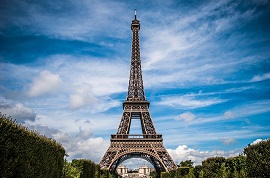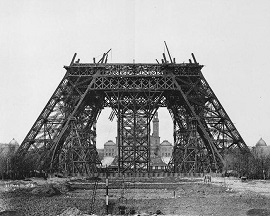Eiffel Tower
Contents |
[edit] Introduction
The Eiffel Tower (Tour Eiffel), situated on the Left Bank of the Seine River in Paris, is an iconic symbol of France and one of the most famous buildings in the world.
The tower was designed by Gustave Eiffel for the 1889 Exposition Universelle (World’s Fair), with the intention of commemorating the centenary of the French Revolution. Eiffel was a renowned civil engineer who specialised in iron construction and had previously worked on the structural framework for New York’s Statue of Liberty, which, standing at 320m, became the world’s tallest building upon its completion; a title it would hold until New York’s Chrysler Building was finished in 1930.
However, it faced fierce opposition from critics before and after its completion, including a petition against the “ridiculous tower dominating Paris like a gigantic black smokestack”. The misjudged petition later featured in the defense of the construction of the Centre Pompidou, which faced similar criticism. The tower also narrowly avoiding being dismantled by the French themselves and destroyed by the invading Nazis, but despite these problematic early years, it went on to become one of the most popular monuments in the world, with around 7 million visitors a year to its 3 different platform heights.
[edit] Design and construction
Over 100 designs were considered by the French Government for a suitable monument to mark the Exposition Universelle, before they decided on Eiffel’s open-lattice wrought iron design. Eiffel’s idea was for the four supporting pillars to be aligned to the points of the compass.
The tower is built of very pure structural iron which makes it relatively extremely light and means that it moves under high wind loading.
The construction of the tower was a remarkable architectural achievement. 18,038 pieces of iron were fitted together with 2.5 million rivets by around 300 steel workers, completed in just 2 years, 2 months and 5 days.
[edit] Survival
Despite being a tourist success, the Eiffel Tower was originally intended to be a temporary structure. The land on which the tower stood was deemed to be of too high a value to be dominated by the tower and so plans were made to dismantle it. These plans were abandoned when the First World War broke out and the tower was adapted to become a military radio and telegraph centre.
When the Nazi’s faced the end of their occupation of Paris, Hitler gave orders to destroy the tower, along with Notre Dame Cathedral; however, these orders were disobeyed.
Subsequent mismanagement meant that by 1980 the tower was in a poor state of disrepair and required significant and expensive renovation and restoration work, including the installation of new elevators and new paintwork.
With its restaurants and various other exhibits and installations, the Eiffel Tower remains an enduring icon of the built environment as well as of France as a country, with many imitations around the world, most notably in Las Vegas. It is regularly used as the centre-piece for events and it is estimated that 250 million people have visited it since 1889.
[edit] Project data
- Location: 7th arrondiseement, Paris, France.
- Construction period: 1887 – 1889.
- Height: 324m.
- Floor count: 3.
- No. of elevators: 9.
[edit] Find out more
[edit] Related articles on Designing Buildings Wiki
- 7 Engineering Wonders of the World.
- 9 of the world’s most impressive structures.
- Building of the week series.
- Burj al Arab, Dubai.
- Centre Pompidou.
- Florence Cathedral.
- Leaning Tower of Pisa.
- Mirage - Montparnasse Tower renovation.
- Palace of Westminster.
- Parthenon.
- Roman Colosseum.
- Space Needle.
- Stainless steel in construction.
- Tallest buildings in the world.
- The Iron Bridge.
- UNIC, Paris.
[edit] External references
[edit] Building of the week series
Featured articles and news
Delivering for tenants; National Retrofit Hub
New report offers recommendations to strengthen energy efficiency standards to protect private renters.
Government consultations for the summer of 2025
A year of Labour, past and present consultations on the environment, the built environment, training and tax.
CMA competitiveness probe of major housing developers
100 million affordable housing contributions committed with further consultation published.
Homes England supports Greencore Homes
42 new build affordable sustainable homes in Oxfordshire.
Zero carbon social housing: unlocking brownfield potential
Seven ZEDpod strategies for brownfield housing success.
CIOB report; a blueprint for SDGs and the built environment
Pairing the Sustainable Development Goals with projects.
Types, tests, standards and fires relating to external cladding
Brief descriptions with an extensive list of fires for review.
Latest Build UK Building Safety Regime explainer published
Key elements in one short, now updated document.
UKGBC launch the UK Climate Resilience Roadmap
First guidance of its kind on direct climate impacts for the built environment and how it can adapt.
CLC Health, Safety and Wellbeing Strategy 2025
Launched by the Minister for Industry to look at fatalities on site, improving mental health and other issues.
One of the most impressive Victorian architects. Book review.
Common Assessment Standard now with building safety
New CAS update now includes mandatory building safety questions.
RTPI leader to become new CIOB Chief Executive Officer
Dr Victoria Hills MRTPI, FICE to take over after Caroline Gumble’s departure.
Social and affordable housing, a long term plan for delivery
The “Delivering a Decade of Renewal for Social and Affordable Housing” strategy sets out future path.
A change to adoptive architecture
Effects of global weather warming on architectural detailing, material choice and human interaction.
The proposed publicly owned and backed subsidiary of Homes England, to facilitate new homes.
How big is the problem and what can we do to mitigate the effects?
Overheating guidance and tools for building designers
A number of cool guides to help with the heat.
The UK's Modern Industrial Strategy: A 10 year plan
Previous consultation criticism, current key elements and general support with some persisting reservations.
Building Safety Regulator reforms
New roles, new staff and a new fast track service pave the way for a single construction regulator.




























Comments